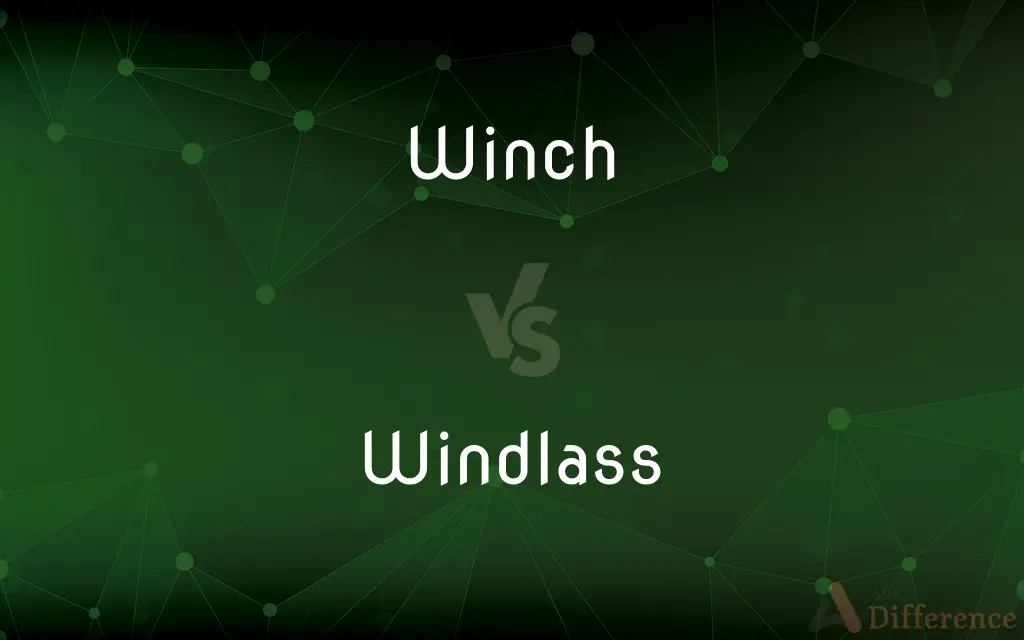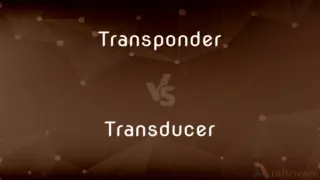Winch vs. Windlass — What's the Difference?
By Tayyaba Rehman — Updated on November 7, 2023
A winch is a device for pulling or lifting, while a windlass is specifically for raising anchors or hauling on shipboard.

Difference Between Winch and Windlass
Table of Contents
ADVERTISEMENT
Key Differences
A winch is a mechanical device equipped with a drum, around which a rope or chain winds, used for lifting, pulling, or tensioning purposes. It can be manual or powered by electric, hydraulic, or pneumatic motors. Windlass, on the other hand, refers specifically to a type of winch that is predominantly used on ships to raise the anchor and is typically operated in a horizontal orientation.
Winches are versatile tools found in various settings, including off-road vehicles, cranes, and tow trucks, aiding in recovery or moving heavy loads. Each winch has a cable wound around a drum, and they often include a gear system for control. Windlasses, however, are not as widespread in usage; they are specialized for nautical applications, utilizing either a rope or chain to operate and often incorporate a gypsy for chain management.
The design of a winch allows it to be used in many orientations and for different applications beyond marine, such as in construction or entertainment rigging. Windlasses are designed with a horizontal axle and are usually installed on the deck of a vessel, making them unique to maritime environments, where they play a crucial role in managing the heavy loads associated with mooring and anchoring.
While winches can be portable and installed in various locations, windlasses are generally a fixed part of a ship's equipment. The functionality of winches extends to pulling objects towards them, whereas windlasses are primarily about lifting vertically, such as pulling an anchor up from the seabed towards the deck of a ship.
In terms of operation, winches may be found with remote controls, especially in modern applications for safety and convenience. Windlasses, while they can also be operated remotely, have a historical association with manual operation, often involving a capstan used for additional mechanical advantage during the raising of an anchor.
ADVERTISEMENT
Comparison Chart
Primary Use
Lifting or pulling loads
Raising anchors on ships
Operation
Can be manual or powered, versatile use
Often manual, specifically for marine use
Installation
Portable or fixed, variable orientation
Typically fixed and horizontal
Associated With
Vehicles, construction, rigging
Maritime, boating
Design Features
May include remote control, various drums
Usually includes a gypsy for chains
Compare with Definitions
Winch
A device for pulling or lifting heavy objects using a rope or cable.
They used a winch to hoist the fallen tree trunk.
Windlass
A horizontal-axle rotating machine that applies force to a rope or chain.
The old ship had a traditional windlass that required multiple sailors to operate.
Winch
A mechanical tool with a hand crank or motor to wind in or out a cable.
The off-road driver activated the winch to pull his truck out of the mud.
Windlass
Maritime equipment typically found on the bow of a boat.
The windlass on the bow was instrumental in managing the ship's heavy chains.
Winch
An apparatus used for tensioning a rope to move or lift objects.
The workers attached the cable to the winch to tighten the suspension bridge cables.
Windlass
A kind of winch specifically designed for marine applications.
The sailboat was equipped with a manual windlass for anchor retrieval.
Winch
A winch can also refer to the action of using such a device.
They had to winch the damaged car up the slope.
Windlass
A device for hoisting that uses gears and a crank or motor.
The windlass made quick work of lifting the heavy nets onto the deck.
Winch
A piece of equipment often seen on the front of tow trucks and trailers.
The tow truck's winch was powerful enough to recover the vehicle from the ditch.
Windlass
The windlass is an apparatus for moving heavy weights. Typically, a windlass consists of a horizontal cylinder (barrel), which is rotated by the turn of a crank or belt.
Winch
A winch is a mechanical device that is used to pull in (wind up) or let out (wind out) or otherwise adjust the tension of a rope or wire rope (also called "cable" or "wire cable"). In its simplest form, it consists of a spool (or drum) attached to a hand crank.
Windlass
Any of numerous hauling or lifting machines consisting essentially of a horizontal cylinder turned by a crank or a motor so that a line attached to the load is wound around the cylinder.
Winch
A hauling or lifting device consisting of a rope or chain winding round a horizontal rotating drum, turned typically by a crank or by motor.
Windlass
To raise with a windlass.
Winch
The crank of a wheel or axle.
Windlass
Any of various forms of winch, in which a rope or cable is wound around a cylinder, used for lifting heavy weights
Winch
Hoist or haul with a winch
An attempt to winch survivors of the wreck into a helicopter
Windlass
A winding and circuitous way; a roundabout course.
Winch
A stationary motorized or hand-powered machine used for hoisting or hauling, having a drum around which is wound a rope, cable, or chain attached to the load being moved.
Windlass
An apparatus resembling a winch or windlass, for bending the bow of an arblast, or crossbow.
Winch
The crank used to give motion to a grindstone or similar device.
Windlass
To raise with, or as if with, a windlass; to use a windlass.
Winch
To move with or as if with a winch.
Windlass
To take a roundabout course; to work warily or by indirect means.
Winch
A machine consisting of a drum on an axle, a friction brake or ratchet and pawl, and a crank handle or prime mover (often an electric or hydraulic motor), with or without gearing, to give increased mechanical advantage when hauling on a rope or cable.
Windlass
A winding and circuitous way; a roundabout course; a shift.
Winch
(nautical) A hoisting machine used for loading or discharging cargo, or for hauling in lines. (FM 55-501).
Windlass
A machine for raising weights, consisting of a horizontal cylinder or roller moving on its axis, and turned by a crank, lever, or similar means, so as to wind up a rope or chain attached to the weight. In vessels the windlass is often used instead of the capstan for raising the anchor. It is usually set upon the forecastle, and is worked by hand or steam.
Winch
A wince (machine used in dyeing or steeping cloth).
Windlass
An apparatus resembling a winch or windlass, for bending the bow of an arblast, or crossbow.
Winch
A kick, as of an animal, from impatience or uneasiness.
Windlass
To take a roundabout course; to work warily or by indirect means.
Winch
(Nigeria, slang) Witch.
Windlass
To raise with, or as with, a windlass; to use a windlass.
Winch
To use a winch
Winch in those sails, lad!
Windlass
Lifting device consisting of a horizontal cylinder turned by a crank on which a cable or rope winds
Winch
To wince; to shrink
Windlass
A rotating device used for raising or hauling in a ship's anchor.
The crew engaged the windlass to raise the anchor as we left port.
Winch
To kick with impatience or uneasiness.
Winch
To wince; to shrink; to kick with impatience or uneasiness.
Winch
A kick, as of a beast, from impatience or uneasiness.
Winch
A crank with a handle, for giving motion to a machine, a grindstone, etc.
Winch
An instrument with which to turn or strain something forcibly.
Winch
An axle or drum turned by a crank with a handle, or by power, for raising weights, as from the hold of a ship, from mines, etc.; a windlass.
Winch
A wince.
Winch
Lifting device consisting of a horizontal cylinder turned by a crank on which a cable or rope winds
Winch
Pull or lift up with or as if with a winch;
Winch up the slack line
Common Curiosities
What is a winch?
A winch is a mechanical device used for pulling, lifting, or tensioning a load using a rope or cable.
What is a windlass?
A windlass is a specialized winch used on ships to raise anchors and haul ropes or chains.
Can a winch be used for the same purpose as a windlass?
While a winch can sometimes serve similar functions, a windlass is specifically designed for marine use.
Are windlasses part of standard boat equipment?
Windlasses are standard on boats that are designed to anchor, especially larger vessels.
Is a windlass installed only on the deck of a ship?
Traditionally, yes, windlasses are installed on the deck, but modern designs can vary.
Can winches be used on boats?
Yes, winches are used on boats but typically for different purposes than a windlass.
Do winches have gears?
Many winches have a gear system for better control of the load.
How is a winch powered?
Winches can be powered manually, electrically, hydraulically, or pneumatically.
What type of rope is used with a windlass?
Windlasses use either specialized ropes or chains depending on the design.
Can a winch be installed on any vehicle?
While many vehicles can be outfitted with a winch, it requires proper mounting and power supply.
Are all windlasses manual?
No, windlasses can be either manual or powered, often electrically.
Can windlasses be used for towing?
Windlasses are not designed for towing; they are meant for lifting and hauling vertically.
Is it safe to operate a windlass without training?
Operating a windlass, especially a manual one, should be done with an understanding of its mechanics and safety procedures.
Do winches need maintenance?
Yes, winches require regular maintenance to ensure proper functionality.
What's the difference between a capstan and a windlass?
A capstan is vertical, while a windlass is horizontal, but both serve to move ropes or chains.
Share Your Discovery

Previous Comparison
Transponder vs. Transducer
Next Comparison
Goods vs. ProductAuthor Spotlight
Written by
Tayyaba RehmanTayyaba Rehman is a distinguished writer, currently serving as a primary contributor to askdifference.com. As a researcher in semantics and etymology, Tayyaba's passion for the complexity of languages and their distinctions has found a perfect home on the platform. Tayyaba delves into the intricacies of language, distinguishing between commonly confused words and phrases, thereby providing clarity for readers worldwide.














































